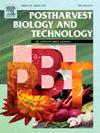外源性甲磺酸去铁胺可抑制由交替孢属和藤黄镰刀菌引起的蓝莓采后果实腐烂病中的铁依赖性铁变态反应
IF 6.4
1区 农林科学
Q1 AGRONOMY
引用次数: 0
摘要
植物的生长发育在很大程度上依赖于受调控的细胞死亡,这对于植物对生物压力的特定反应至关重要。最近在动物细胞中发现了一种铁依赖性、氧化性和非凋亡性细胞死亡形式--铁凋亡。在这项研究中,我们调查了类似铁凋亡的过程是否与由交替孢属(Alternaria alternata)和富坚黑镰刀菌(Fusarium fujikuroi)引起的蓝莓采后果实腐烂病中的细胞死亡有关。结果表明,甲磺酸去铁胺和谷胱甘肽(GSH)处理的果实表现出更强的抗病性,病变面积更小,而过氧化氢(H2O2)处理的果实则表现出相反的结果,这表明在真菌感染的蓝莓果实中可能存在细胞内的铁突变。与对照组相比,甲磺酸去铁胺或 GSH 处理改善了叶绿素荧光参数,有助于光合作用的稳定。在感染果实邻近区域的铁突变途径方面,甲磺酸去铁胺抑制了铁依赖性细胞死亡途径,该途径的特征是 H2O2 和 MDA 的耗竭和 GSH 的积累,以及亚铁离子和总铁离子的减少。同时,甲磺酸去铁胺能有效延缓真菌感染果实在贮藏过程中不饱和值和关键磷脂的下降速度,从而可能保持细胞膜的完整性。由于病变区域腐烂严重,膜脂过氧化反应严重,并伴有代谢紊乱。这些综合结果表明,甲磺酸去铁胺处理可通过螯合 Fe2+ 减少芬顿反应,避免活性氧(ROS)的过度积累,抑制铁依赖性铁变态反应,从而保持果实品质,减少采后病害。本文章由计算机程序翻译,如有差异,请以英文原文为准。
Exogenous deferoxamine mesylate suppresses iron-dependent ferroptosis in postharvest fruit rot of blueberry caused by Alternaria alternata and Fusarium fujikuroi
Plant development relies heavily on regulated cell death, which is crucial for specific plant responses to biological stresses. Ferroptosis, an iron-dependent, oxidative, and non-apoptotic cell death form, has been recently discovered in animal cells. In this study, we investigated whether a ferroptosis-like process could be relevant to cell death in postharvest fruit rot of blueberry caused by Alternaria alternata and Fusarium fujikuroi. The results showed that deferoxamine mesylate and glutathione (GSH) treated fruit showed enhanced disease resistance with lower lesion areas, whereas an opposite result was observed in hydrogen peroxide (H2O2) treatment, indicating that intracellular ferroptosis might exist in the fungal infected blueberry fruit. Compared to control, deferoxamine mesylate or GSH treatment improved chlorophyll fluorescence parameters, which contributed to the stability of photosynthesis. In terms of ferroptosis pathway in the adjacent area of infected fruit, deferoxamine mesylate suppressed an iron-dependent cell death pathway that was characterized by depletion of H2O2 and MDA and accumulation of GSH, as well as the reduction of ferrous ions and total iron ions. Meanwhile, deferoxamine mesylate could effectively delay the decrease rate of unsaturation value and key phospholipids of fungi infected fruit during storage, which possibly maintained the integrity of cell membrane. Due to the serious rot of the lesion area, the peroxidation of membrane lipids was severe, accompanied by metabolic disorders. These combined results demonstrated that deferoxamine mesylate treatment could reduce Fenton reaction by chelating Fe2+ and avoid excessive accumulation of reactive oxygen species (ROS), suppress iron-dependent ferroptosis, thereby maintaining fruit quality and reducing postharvest diseases.
求助全文
通过发布文献求助,成功后即可免费获取论文全文。
去求助
来源期刊

Postharvest Biology and Technology
农林科学-农艺学
CiteScore
12.00
自引率
11.40%
发文量
309
审稿时长
38 days
期刊介绍:
The journal is devoted exclusively to the publication of original papers, review articles and frontiers articles on biological and technological postharvest research. This includes the areas of postharvest storage, treatments and underpinning mechanisms, quality evaluation, packaging, handling and distribution of fresh horticultural crops including fruit, vegetables, flowers and nuts, but excluding grains, seeds and forages.
Papers reporting novel insights from fundamental and interdisciplinary research will be particularly encouraged. These disciplines include systems biology, bioinformatics, entomology, plant physiology, plant pathology, (bio)chemistry, engineering, modelling, and technologies for nondestructive testing.
Manuscripts on fresh food crops that will be further processed after postharvest storage, or on food processes beyond refrigeration, packaging and minimal processing will not be considered.
 求助内容:
求助内容: 应助结果提醒方式:
应助结果提醒方式:


